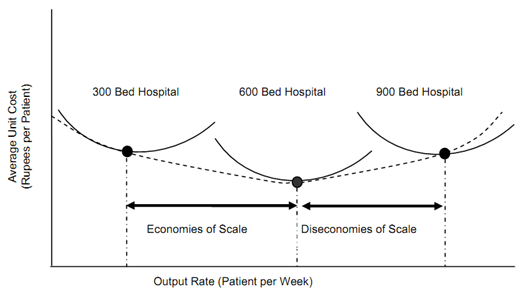Diseconomies of Scale:
Capacity Planning
At some point of time a facility can become so large that the average cost per unit increases as the facility's size increases. One of the common reasons is that excessive size can bring complication, loss of focus, and inefficiencies that raise the average unit costs of a product or service. There can be too many layers of workers and administration, management loses touch with the workers and customers. The organization is less alert and the flexibility needed to respond to the changing demand. Several large companies become so involved in analysis & planning that they innovate less and ignore risks. The result is that the small companies outperform corporate giants in several industries.

Figure: Economies and Diseconomies of Scale
Figure illustrates the transition from economies of scale to diseconomies of scale. The 600 bed hospital shows economies of scale because the average unit cost at its best operating level is less than that of the 300 bed hospital. Though, if the further expansion of 300 beds that means 900 beds are done, and then it leads to higher average unit costs and diseconomies of scale. Hospital having 600 bed hospitals enjoys greater economies of scale than the 300 bed hospital, because the cost of building and equipping is less than twice the cost for smaller hospital. The 300 bed facility would enjoy similar savings. Their higher average unit cost is because of diseconomies of scale, which outweigh the savings realized in the construction costs. Figure does not mean that the optimal size for all of the hospitals is 600 beds. The best size based upon the number of patients per week to be served. In the hospital, having small community would have lower costs by choosing 300 bed capacities rather than 600 bed capacity. A large residential area can be more effectively served by two 600 bed capacity hospitals than a single 1200 bed capacity hospital.
Economies of scale change from industry to industry greatly affect the size of plants. Therefore, managers have to set the policies regarding the maximum size for any one facility. Where economies of scale are strong, the most challenging issue in setting is to predict how costs and revenues will change for different output rates and facility sizes.